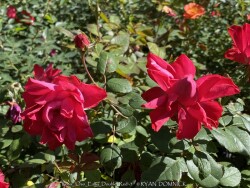

This rose earns its spot in the Winner's Circle! There's so much to love about Oso Easy Double Red® rose - its lush, deep red color. The way the blooms are held on long stems, well above the foliage, for a truly memorable display. And speaking of foliage, it's a beautiful, lustrous green with excellent resistance to powdery mildew and black spot, so it stays looking good all season. No need to deadhead to keep those beautiful blooms coming, too! Oso Easy Double Red rose is a bit of a bigger plant - about 3-4'/.9-1.2 m tall and wide, but give it enough space in a sunny location, and you've given yourself the gift of an easy-care rose that you'll love to look at all season long. In Lawrence Kansas, performance has been impressive and low maintenance. Currently, no serious pest problems exist but we are careful not to recommend planting roses in large mass groupings in case a pest or disease like Rose Rosette Virus (RRV) becomes a problem. Mixed small plantings of roses and non-host plants may slow the spread of RRV in landscape plantings. As with most roses, thorns may be an issue with children or pets. Usually rose thorns are short and don't cause any serious injury: it creates more of a life lesson about respecting and being careful around the dangers in our world. All Proven Winners® plants are legally propagated, healthy and vigorous, true to name, and tagged with color pictures and growing information.
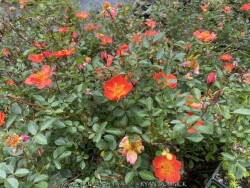

Spice up your landscape! Oso Easy® Paprika rose is a landscape classic - and now, it has a modern update. Meet Oso Easy Hot Paprika® - like its namesake, it flowers from early summer through frost on a versatile, low-growing plant. It also shares its outstanding hardiness and disease resistance. Its flowers, however, light up the garden in an electric glowing orange for a bold new look. Available in better garden centers in spring 2018. In Lawrence Kansas, performance has been impressive and low maintenance. Currently, no serious pest problems exist but we are careful not to recommend planting roses in large mass groupings in case a pest or disease like Rose Rosette Virus (RRV) becomes a problem. Mixed small plantings of roses and non-host plants may slow the spread of RRV in landscape plantings. As with most roses, thorns may be an issue with children or pets. Usually rose thorns are short and don't cause any serious injury: it creates more of a life lesson about respecting and being careful around the dangers in our world. All Proven Winners® plants are legally propagated, healthy and vigorous, true to name, and tagged with color pictures and growing information.


Still think yellow roses are tough to grow? Not this rebel! We evaluated yellow roses for years, looking for one that lived up to our demands for brilliant color and excellent disease-resistance. This is it! Sunny, canary yellow flowers do not fade to white, and really light up against the glossy green foliage. It is free-flowering, producing lots of buds which open to self-cleaning flowers. Superior disease-resistance makes it easy for gardeners to enjoy. Winner of an Award of Excellence from the American Rose Society. In Lawrence Kansas, performance has been impressive and low maintenance. Currently, no serious pest problems exist but we are careful not to recommend planting roses in large mass groupings in case a pest or disease like Rose Rosette Virus (RRV) becomes a problem. Mixed small plantings of roses and non-host plants may slow the spread of RRV in landscape plantings. As with most roses, thorns may be an issue with children or pets. Usually rose thorns are short and don't cause any serious injury: it creates more of a life lesson about respecting and being careful around the dangers in our world. All Proven Winners® plants are legally propagated, healthy and vigorous, true to name, and tagged with color pictures and growing information.
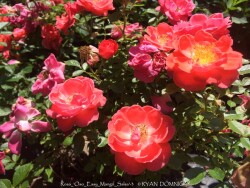

If you think roses are for very proper, formal gardens, think again. This rebel has intense, amazing color: shades of ruby-red grapefruit, summer sunsets, and those fancy tropical drinks with umbrellas in them. The continuous blooms cover the tidy mound of dark, glossy foliage. This is a wonderful choice for mass plantings or adding unusual color to mixed borders In Lawrence Kansas, performance has been impressive and low maintenance. Currently, no serious pest problems exist but we are careful not to recommend planting roses in large mass groupings in case a pest or disease like Rose Rosette Virus (RRV) becomes a problem. Mixed small plantings of roses and non-host plants may slow the spread of RRV in landscape plantings. As with most roses, thorns may be an issue with children or pets. Usually rose thorns are short and don't cause any serious injury: it creates more of a life lesson about respecting and being careful around the dangers in our world. All Proven Winners® plants are legally propagated, healthy and vigorous, true to name, and tagged with color pictures and growing information.
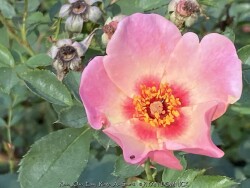

When you're this colorful, you only need five petals for big impact! The pleasing flowers of Ringo All-Star rose may look simple at first, but this plant packs in a lot of interest. The flowers start out a rich melon-orange with a cherry-red center. As each one ages, it transforms to lavender and pink, creating a look of multiple colors on one plant. A crown of fluffy yellow anthers bedecks the center and attracts pollinators. As with all Proven Winners roses, Ringo All-Star is disease resistant and low maintenance. No need to trim or deadhead to keep those fab flowers coming all season! In Lawrence Kansas, performance has been impressive and low maintenance. Currently, no serious pest problems exist but we are careful not to recommend planting roses in large mass groupings in case a pest or disease like Rose Rosette Virus (RRV) becomes a problem. Mixed small plantings of roses and non-host plants may slow the spread of RRV in landscape plantings. As with most roses, thorns may be an issue with children or pets. Usually rose thorns are short and don't cause any serious injury: it creates more of a life lesson about respecting and being careful around the dangers in our world. All Proven Winners® plants are legally propagated, healthy and vigorous, true to name, and tagged with color pictures and growing information.
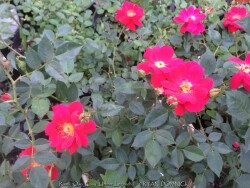

A bright red rose with non-stop blooms! Oso Easy® Urban Legend® is a bright and vigorous member of this best-selling series of disease-resistant landscape roses. True-red, semi-double flowers in early summer and continue through the first hard frost. A crown of lush yellow stamens in the center add interest and contrast. Dark green glossy foliage resists powdery mildew and black spot.In Lawrence Kansas, performance has been impressive and low maintenance. Currently, no serious pest problems exist but we are careful not to recommend planting roses in large mass groupings in case a pest or disease like Rose Rosette Virus (RRV) becomes a problem. Mixed small plantings of roses and non-host plants may slow the spread of RRV in landscape plantings. As with most roses, thorns may be an issue with children or pets. Usually rose thorns are short and don't cause any serious injury: it creates more of a life lesson about respecting and being careful around the dangers in our world. All Proven Winners® plants are legally propagated, healthy and vigorous, true to name, and tagged with color pictures and growing information.
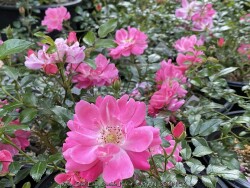

Imagine your garden with non-stop pink roses! Oso Easy® Double Pink rose is simply an unstoppable bloomer. In our many years evaluating it, it was rarely without its fully petaled, true pink blooms - it just wants to flower and flower and flower. All roses that we consider must prove to be resistant to common rose maladies like powdery mildew and black spot and Oso Easy Double Pink passed that test with flying colors! If you want to enjoy months of flowers with minimal effort, this rose deserves a spot in your landscape. In Lawrence Kansas, performance has been impressive and low maintenance. Currently, no serious pest problems exist but we are careful not to recommend planting roses in large mass groupings in case a pest or disease like Rose Rosette Virus (RRV) becomes a problem. Mixed small plantings of roses and non-host plants may slow the spread of RRV in landscape plantings. As with most roses, thorns may be an issue with children or pets. Usually rose thorns are short and don't cause any serious injury: it creates more of a life lesson about respecting and being careful around the dangers in our world. All Proven Winners® plants are legally propagated, healthy and vigorous, true to name, and tagged with color pictures and growing information.
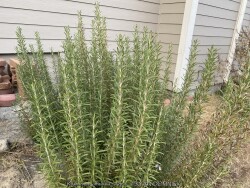

Rosemary is one of the most well-known herbal and edible plants. It features grayish green aromatic and evergreen foliage with small white flowers. Blooming is usually short-lived and not a main reason to grow Rosemary. This plant is native to Mediterranean climates with average moisture in the summer and dry, mild winters. Because of its heritage, it resents cold wet winters and needs well-drained sandy, silty, or rocky soil. In the short term, it will typically grow in any soil during the summer making it very useful even as an annual. In Kansas landscapes, it is commonly used as an annual or short-lived perennial with winter kill (below 0 to -10 degrees F) being it's number one enemy. It does not have very good ability to come back from the lower portion of the stem or root system like other perennials after winter-kill. Root rot is also likely when placed in poor draining soil and sometimes even in rich garden soil. Summer heat not a problem; to have a chance of survival as a perennial, plant in a protected area on a South or West wall. Rosemary is actually a woody shrub in mild zone 8 and 9 climates and grown like a in perennial in zone 6/7. When grown as a perennial, every so often you do need to trim it back to a few inches off the ground. Rosemary combines nicely with any other flowers or where needing a perennial with evergreen winter color. In Kansas, Rosemary is commonly grown as an outdoor patio plant that you move in for the winter to enjoy fresh clippings. When grown that way, remember that Rosemary is cold hardy to about 0 degrees F so you can skip the first few freezes before moving it in if you forget. This delay is probably beneficial because if you keep it in the house too long especially with poor light it will display poor quality elongated growth and die. Keep in a bright window and do not let it dry out completely. Strangely enough being from a desert climate, rosemary doesn't really warn you by wilting, if the soil gets extremely dry for too long, it just suddenly dries up and dies. Despite all of these pointers, rosemary is very easy to overwinter in the house when placing back out in the following spring. 'Arp' is exceptionally cold hardy; possibly the most cold hardy rosemary being a treu perennial in zone 6 with dark blue hummingbird feeding flowers.
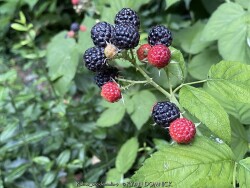

Raspberry (Rubus occidentalis) is an "easy to grow" edible fruit that is worth growing in Kansas. Store-bought raspberries are expensive and don't taste as good as garden grown fruits. All cultivars of raspberries have perennial roots, but most top shoots only live for two years. (meaning shoots grow in the first growing season and fruits grow on those shoots during the second growing season) The cycle is repeated; maintenance involves removing old canes after decline or death. Raspberries are vigorous and can be locally invasive in the garden but rarely invasive in the wild. They propagate by basal shoots (also known as suckers) spreading some distance from the main plant. After establishment, it is high maintenance if it has already filled the space and you don't want it to spread any further so plan accordingly. In the landscape, raspberry and blackberry mix well into garden designs with ornamental plants as long as you create it's own area (like a background fence to train plants on) The main difference between raspberry and blackberry are that the fruit releases from the raspberry differently. The "torus" or inside center of the fruit is hollow and releases from the stem with raspberry. With Blackberry, the "torus" or center "picks with" the fruit giving a solid fruit to eat. (just in case you have always wondered) Native Black Raspberry (Rubus occidentalis) is a true native plant to Kansas lightly shaded woods, open moist prairies, disturbed areas (especially those that are logged or cut), and near streams and lakes, trails or roadways. Ripe fruit is black instead of red. Fruit production is rather brief compared to commercially available varieties (one big flush of fruits ripen for a couple weeks and that's it) Foliage is bluish-green with powdery white flocked backsides and irridescent bluish-purple stems add nice ornamental value! Also called black cap raspberry.


>>>>>All Proven Winners® plants are legally propagated, healthy and vigorous, true to name, and tagged with color pictures and growing information.
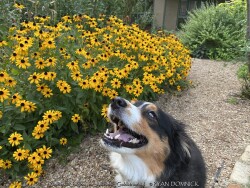

Fulgida Native Black-eyed Susan, is also known as Rudbeckia fulgida var. Fulgida
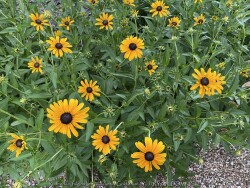

***Description for this plant available with future update!*** >>>> Good variety for customers with irrigation systems that water too much for other Black-eye Susan varieties.
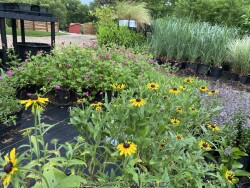

Native Black-eyed Susan, is also known as Rudbeckia hirta
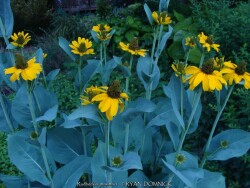

Great Coneflower / Blue-Leaf Coneflower, is also known as Rudbeckia maxima


***Description for this plant available with future update!***


Hardy Pampas Grass / Plume Grass, is also known as Saccharum / Erianthus ravennae
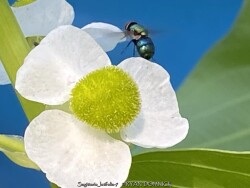

>>>>>This plant is usually grown as a bog plant needing constantly moist soil rich in organic matter. As a rain garden plant, it will thrive is a depressed area in the landscape that collects rain water from a roof during spring and summer periods of rain but then go dormant if the water hole dries out completely. For the home garden, the species is generally too aggressive to mix with other plants
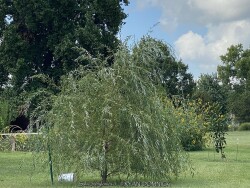

***Tree descriptions available with future update!***
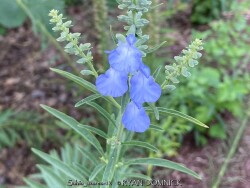

***Description for this plant available with future update!***
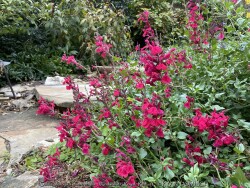

>>>>>Red sage is a wonderful heavily flowering perennial found in Texas and higher election Mexico. Foliage is evergreen to about 0°, Beyond that, it becomes a deciduous perennial hardy to about -15 before complete death would occur. During years in which the foliage remains evergreen, and blooms on old word covering the plants during the month of April. If dieback occurs, blooms will still be dramatic but will be delayed until May on new growth. If Diback does not occur naturally, it is recommended to cut back anyways every 2 to 3 years to maintain bushiness. During the summer, foliage maintains very well with heat and drought with sporadic blooming. Another flush of heavy flowering occurs in fall and continues until hard freezes sometimes into November in our Lawrence Kansas zone6 climate. In the landscape, Red Sage is best on a hot south or west side of a house, on a south side of a berm, or any sunny garden area with some North wind protection. The flower power is so great that it would even be worth using red sage as a short-lived perennial or annual though. Growth in containers is amazing when used as an annual. As with any zone6 perennials, be sure to mulch 2 to 3 inches deep to guard against temperatures below -10F. Red sage needs well drained soils on the dry side but summer irrigation is OK. There is quite a bit of variability within the salvia Greggy species with lots of different colors and heights ranging from 1 to 4 feet. This is a true butterfly magnet; I have seen hundreds of yellow sulfur butterflies visiting at the same time as shown in one of our pictures.
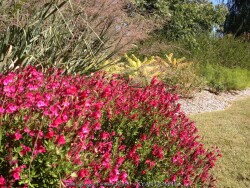

>>>>>In Lawrence, KS (zone 6a), many dozen established specimens survived -17 degrees F. During the arctic blast of February, 2021, lows down to -17 degrees F on Feb 16th, 2021 were recorded. The longevity of this cold blast was also impressive: 10 days on a row with highs of 10-15 degrees F or lower, 8 nights of lows in the single digits and negatives, and 36 strait hours of 0 degrees F and mostly lower. All survivors had winter sun with South exposures, those without perrished. Repeated or successive cold winters with complete foliage loss seem can be an issue with this and many evergreen zone 6/7 plants. One occasional difficult winter followed by mild winters is more tolerable. This is, however, a very vigorous growing plant so generally will recover in one summer. Avoid North-facing exposures, North sides of a berm, and spots with excessive snow accumulation.
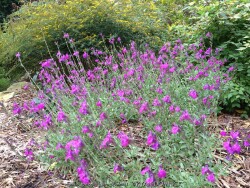

Ultra Violet Autumn Sage, is also known as Salvia greggii 'Ultra Violet'
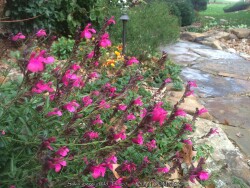

>>>>>In Eastern Kansas, this cultivar performs WELL with just about everything nature has to challenge it! Extreme heat and drought are tolerated. Cold tolerance is no problem in our zone 6. If winter die-back occurs, cut back in March/April and flowers will occur on new growth this year. No disease or pest problems. Great plant for berms, hot West or South exposures, and most any other garden situations in full sun. Will tolerate clay soils and extra moisture in summer. Combine with caryopteris, crapemyrtle, and butterflybush to create a late season "all you can eat" buffet for pollinators!
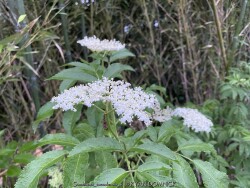

American Elderberry (Sambucus canadensis) is a large spreading shrub with interesting foliage, white flowers and deep purple blackberries. Elderberry is native to a large part of the US (Eastern Midwestern and Northern areas) including Kansas. Large white flower clusters attract bees and other kinds of pollinators for about a month in June. Decent growth will occur in both sun or full shade but growth is open and coarse textured either way. Flowering and fruiting will diminish with increasing shade but not go away completely. American elderberry tolerates a wide variety of wet to dry soils but prefers rich, moist, slightly acidic soil. Elderberry grows fastest and rich well drained soils but may become too fast and agressive. To slow down or eliminate this suckering tendency, plant in a more stressful sites such as dry shade, dry sunny areas, tight heavy clay soils, or non-irrigated areas. However, if you want absorbent amounts of fruit and spread, designate a large area with rich soil regular water in your garden. A favorite use in the landscape is filling the niche of a large flowering shrub in full shade. Elderberry also makes a great mass planting belong roadways or wild areas. Large flowers and copious amounts of fruit make this a great wildlife friendly plant. As you may have already heard, elderberries may be harvested and processed into an array of juices, syrups, and products with immune system stimulating qualities. The raw fruit should be boiled before eaten. Select cultivars have been produced with drastically increased fruit yields. Although self-fertile, more fruit set occurs with cross-polination
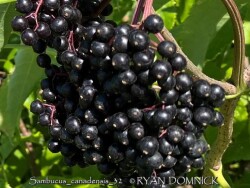

American Elderberry (Sambucus canadensis) is a large spreading shrub with interesting foliage, white flowers and deep purple blackberries. Elderberry is native to a large part of the US (Eastern Midwestern and Northern areas) including Kansas. Large white flower clusters attract bees and other kinds of pollinators for about a month in June. Decent growth will occur in both sun or full shade but growth is open and coarse textured either way. Flowering and fruiting will diminish with increasing shade but not go away completely. American elderberry tolerates a wide variety of wet to dry soils but prefers rich, moist, slightly acidic soil. Elderberry grows fastest and rich well drained soils but may become too fast and agressive. To slow down or eliminate this suckering tendency, plant in a more stressful sites such as dry shade, dry sunny areas, tight heavy clay soils, or non-irrigated areas. However, if you want absorbent amounts of fruit and spread, designate a large area with rich soil regular water in your garden. A favorite use in the landscape is filling the niche of a large flowering shrub in full shade. Elderberry also makes a great mass planting belong roadways or wild areas. Large flowers and copious amounts of fruit make this a great wildlife friendly plant. As you may have already heard, elderberries may be harvested and processed into an array of juices, syrups, and products with immune system stimulating qualities. The raw fruit should be boiled before eaten. Select cultivars have been produced with drastically increased fruit yields. We have tested the following varieties in Lawrence, KS, all passing with flying colors: Bob Gordon, Wyldewood, and York. Although self-fertile, more fruit set occurs with cross-polination.
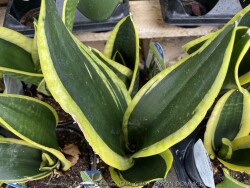

Dark green and gold striped leaves from this Sansevieria (Sansevieria / Dracaena trifasciata 'Black Gold') make an excellent architectural statement. Most Sansevieria are native to are native to rocky, dry habitats in tropical Africa but used as a patio or house plant in Kansas. Grow in full sun to part sun with optional extra watering including that which comes from rainfall. Plants with plenty of time to acclimate will thrive in full sun but be careful not to rush it or sunburning will occur. Generally if moving outside for the summer, allow 2-3 weeks of part shade or morning sun before placing in full sun. Or just keep in part shade or under an overhang. Repotting may or may not be needed depending on how large you want the plant to grow; plants can continue to grow and tolerate extremely root-bound pots but may need wind bracing. Some species root systems will build up enough pressure and will simply break the pot as a friendly reminder when it's time to re-pot! Protect from temperatures below 45 degrees F and move into a bright window over the winter with no watering. Do not allow Sansevieria to freeze or even get close to freezing especially if soil is wet or death may occur. As a winter house plant, it will look presentable all winter long with just a few monthly or no waterings if you forget. As a permanent house plant, provide bright light and allow the soil to dry between waterings for many years of carefree enjoyment. Potted plants are very low maintenance needing only old leaves trimmed once per year. Black Gold Sansevieria is one of the more slow-growing and most sought-after snake plants often grown as a specimen house plant.
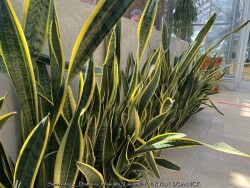

Green and yellow leaves from this Sansevieria (Sansevieria / Dracaena trifasciata 'Laurentii') make an excellent architectural statement. Most Sansevieria are native to are native to rocky, dry habitats in tropical Africa but used as a patio or house plant in Kansas. Grow in full sun to part sun with optional extra watering including that which comes from rainfall. Plants with plenty of time to acclimate will thrive in full sun but be careful not to rush it or sunburning will occur. Generally if moving outside for the summer, allow 2-3 weeks of part shade or morning sun before placing in full sun. Or just keep in part shade or under an overhang. Repotting may or may not be needed depending on how large you want the plant to grow; plants can continue to grow and tolerate extremely root-bound pots but may need wind bracing. Some species root systems will build up enough pressure and will simply break the pot as a friendly reminder when it's time to re-pot! Protect from temperatures below 45 degrees F and move into a bright window over the winter with no watering. Do not allow Sansevieria to freeze or even get close to freezing especially if soil is wet or death may occur. As a winter house plant, it will look presentable all winter long with just a few monthly or no waterings if you forget. As a permanent house plant, provide bright light and allow the soil to dry between waterings for many years of carefree enjoyment. Potted plants are very low maintenance needing only old leaves trimmed once per year. This is the basic big-box store sansevieria is often grown as a house plant.
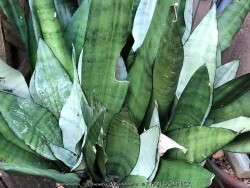

Dwarf whitish green leaves from this Moonshine Sansevieria (Sansevieria / Dracaena trifasciata 'Moonshine') make an excellent architectural statement. Most Sansevieria are native to are native to rocky, dry habitats in tropical Africa but used as a patio or house plant in Kansas. Grow in full sun to part sun with optional extra watering including that which comes from rainfall. Plants with plenty of time to acclimate will thrive in full sun but be careful not to rush it or sunburning will occur. Generally if moving outside for the summer, allow 2-3 weeks of part shade or morning sun before placing in full sun. Or just keep in part shade or under an overhang. Repotting may or may not be needed depending on how large you want the plant to grow; plants can continue to grow and tolerate extremely root-bound pots but may need wind bracing. Some species root systems will build up enough pressure and will simply break the pot as a friendly reminder when it's time to re-pot! Protect from temperatures below 45 degrees F and move into a bright window over the winter with no watering. Do not allow Sansevieria to freeze or even get close to freezing especially if soil is wet or death may occur. As a winter house plant, it will look presentable all winter long with just a few monthly or no waterings if you forget. As a permanent house plant, provide bright light and allow the soil to dry between waterings for many years of carefree enjoyment. Potted plants are very low maintenance needing only old leaves trimmed once per year. Moonshine Sansevieria is one of the more slow-growing and most sought-after snake plants often grown as a specimen house plant.
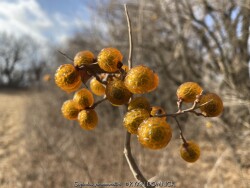

***Tree descriptions available with future update!***
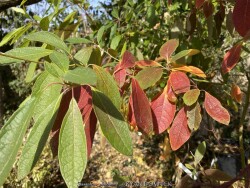

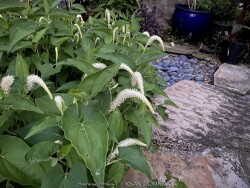

Lizards Tail Water Plant (Saururus cernuus) is a herbaceous perennial that features clean green foliage and white flowers that bloom in the summer months. Leaves are heart-shaped (cordate) and alternate along the stem of the plant. When the leaves are crushed they release a citrus or sassafras aroma. The native range covers much of the eastern United States including eastern Kansas. This plant is often grown as a marginal aquatic plant in standing water or as a potted plant in water gardens. It can also grow as a bog plant needing constantly moist soil rich in organic matter. As a rain garden plant, it will thrive is a depressed area in the landscape that collects rain water from a roof during spring and summer periods of rain but then go dormant if the water hole dries out completely. It may also be grown in average garden soils provided extra water is supplied during droughts. For the home garden, the species is generally too aggressive to mix with other plants. This can also be a problem in a water garden if you fail to divide this plant after several years. Lizard's Tail is a rare water garden plant that can also tolerate shading by larger trees.
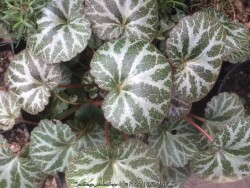

Hardy Strawberry Geranium, is also known as Saxifraga stolonifera


Little bluestem (Schizachyrium scoparium) is a prominent prairie grass usually found in the short to medium grass prairies of Kansas and most common in the midwest and Great Plains. It also occurs sporadically throughout most of the United States in open areas where trees cannot grow. The spring and summer foliage is mint green to blue green. Depending on the variety, they gradually turn a reddish purple color in late summer progressing to deeper reddish purple, red, or orange by fall. At this time when the seed heads have extended, it is at its prettiest. As cold weather sets in and freezes occur, dried foliage turns a pinkish orange with tan and red shades again depending on the variety. Winter color is persistent and lasts until spring cut back in March. Little bluestem is very tolerant of different soils but prefers dry, sandy, loam, or clay soils with plenty of full sun. If planted in rich soil or given too much water, plants tend to grow too tall and flop by late summer. However, there are now improved cultivars that resist flopping. Good air circulation and some wind is needed to avoid rust diseases in humid areas. Sometimes if planted too shallow or if mulched too thickly, plants can heave and die in the winter. In the landscape, little bluestem looks best when planted in medium to large groups giving the look of a miniature prairie. It also combines very well with many other plants that have different textures and colors. Generally if given the proper placement and growing conditions, little bluestem will last indefinitely. Little bluestem as one of the four major grasses (along with Big bluestem, Indiangrass, and Switchgrass) covering millions of acres and Kansas including the Flint Hills. Where and when conditions are safe, it can be burned in late winter or early spring in a prairie or meadow before new growth appears. Many cultivars have been released improving foliage color and flop resistance.


Little bluestem (Schizachyrium scoparium) is a prominent prairie grass usually found in the short to medium grass prairies of Kansas and most common in the midwest and Great Plains. It also occurs sporadically throughout most of the United States in open areas where trees cannot grow. The spring and summer foliage is mint green to blue green. Depending on the variety, they gradually turn a reddish purple color in late summer progressing to deeper reddish purple, red, or orange by fall. At this time when the seed heads have extended, it is at its prettiest. As cold weather sets in and freezes occur, dried foliage turns a pinkish orange with tan and red shades again depending on the variety. Winter color is persistent and lasts until spring cut back in March. Little bluestem is very tolerant of different soils but prefers dry, sandy, loam, or clay soils with plenty of full sun. If planted in rich soil or given too much water, plants tend to grow too tall and flop by late summer. However, there are now improved cultivars that resist flopping. Good air circulation and some wind is needed to avoid rust diseases in humid areas. Sometimes if planted too shallow or if mulched too thickly, plants can heave and die in the winter. In the landscape, little bluestem looks best when planted in medium to large groups giving the look of a miniature prairie. It also combines very well with many other plants that have different textures and colors. Generally if given the proper placement and growing conditions, little bluestem will last indefinitely. Little bluestem as one of the four major grasses (along with Big bluestem, Indiangrass, and Switchgrass) covering millions of acres and Kansas including the Flint Hills. Where and when conditions are safe, it can be burned in late winter or early spring in a prairie or meadow before new growth appears. Many cultivars have been released improving foliage color and flop resistance. Blaze Little Bluestem Grass (Schizachyrium scoparium 'Blaze') is a cultivar originally selected by agronomists in Nebraska as a high yielding pasture grass. Blaze is also used ornamentally for its vivid red fall foliage. In winter it remains a standout as the leaves fade to deep pink and is considered one of the best for winter color.
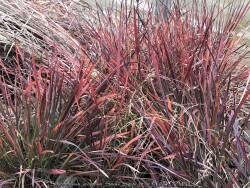

Little bluestem (Schizachyrium scoparium) is a prominent prairie grass usually found in the short to medium grass prairies of Kansas and most common in the midwest and Great Plains. It also occurs sporadically throughout most of the United States in open areas where trees cannot grow. The spring and summer foliage is mint green to blue green. Depending on the variety, they gradually turn a reddish purple color in late summer progressing to deeper reddish purple, red, or orange by fall. At this time when the seed heads have extended, it is at its prettiest. As cold weather sets in and freezes occur, dried foliage turns a pinkish orange with tan and red shades again depending on the variety. Winter color is persistent and lasts until spring cut back in March. Little bluestem is very tolerant of different soils but prefers dry, sandy, loam, or clay soils with plenty of full sun. If planted in rich soil or given too much water, plants tend to grow too tall and flop by late summer. However, there are now improved cultivars that resist flopping. Good air circulation and some wind is needed to avoid rust diseases in humid areas. Sometimes if planted too shallow or if mulched too thickly, plants can heave and die in the winter. In the landscape, little bluestem looks best when planted in medium to large groups giving the look of a miniature prairie. It also combines very well with many other plants that have different textures and colors. Generally if given the proper placement and growing conditions, little bluestem will last indefinitely. Little bluestem as one of the four major grasses (along with Big bluestem, Indiangrass, and Switchgrass) covering millions of acres and Kansas including the Flint Hills. Where and when conditions are safe, it can be burned in late winter or early spring in a prairie or meadow before new growth appears. Many cultivars have been released improving foliage color and flop resistance. Smoke Signal Little Bluestem Grass (Schizachyrium scoparium 'Smoke Signal') has a beautifully refined habit and puts forth a strong show of color in late summer and fall. The glaucous blue-green foliage begins to take on scarlet red tones in late summer, turning a deeper red-purple through the fall. Tiny, tan seed heads appear in early fall on the top half of the stems. An improvement over older cultivars, this grass maintains its strictly upright habit through fall. Smoke Signal is a Walters Gardens Inc. introduction.
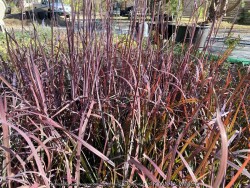

Little bluestem (Schizachyrium scoparium) is a prominent prairie grass usually found in the short to medium grass prairies of Kansas and most common in the midwest and Great Plains. It also occurs sporadically throughout most of the United States in open areas where trees cannot grow. The spring and summer foliage is mint green to blue green. Depending on the variety, they gradually turn a reddish purple color in late summer progressing to deeper reddish purple, red, or orange by fall. At this time when the seed heads have extended, it is at its prettiest. As cold weather sets in and freezes occur, dried foliage turns a pinkish orange with tan and red shades again depending on the variety. Winter color is persistent and lasts until spring cut back in March. Little bluestem is very tolerant of different soils but prefers dry, sandy, loam, or clay soils with plenty of full sun. If planted in rich soil or given too much water, plants tend to grow too tall and flop by late summer. However, there are now improved cultivars that resist flopping. Good air circulation and some wind is needed to avoid rust diseases in humid areas. Sometimes if planted too shallow or if mulched too thickly, plants can heave and die in the winter. In the landscape, little bluestem looks best when planted in medium to large groups giving the look of a miniature prairie. It also combines very well with many other plants that have different textures and colors. Generally if given the proper placement and growing conditions, little bluestem will last indefinitely. Little bluestem as one of the four major grasses (along with Big bluestem, Indiangrass, and Switchgrass) covering millions of acres and Kansas including the Flint Hills. Where and when conditions are safe, it can be burned in late winter or early spring in a prairie or meadow before new growth appears. Many cultivars have been released improving foliage color and flop resistance. Standing Ovation Little Bluestem Grass (Schizachyrium scoparium 'Standing Ovation') is characterized by its wide leaf blades and its blue foliage with red tips throughout the growing season that change to red and maroon in fall with rich purple coloring at the base. It is upright and has a rigid habit that is retained without lodging when plants are grown in rich soils or during container production. Standing Ovation is a North Creek Nurseries Inc. introduction from Pennsylvania.


***Description for this perennial available with future update!***
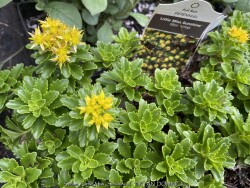

Little Miss Sunshine Sedum, is also known as Sedum 'Little Miss Sunshine'
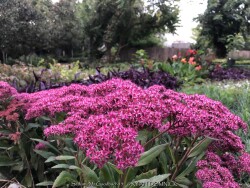

Mr.Goodbud / Carl Sedum, is also known as Sedum 'Mr.Goodbud / Carl'
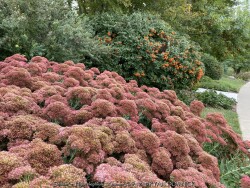

Autumn Fire Sedum, is also known as Sedum / Hylotelephium 'Autumn Fire'
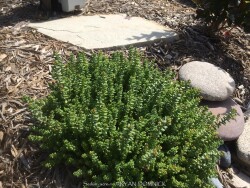

Mossy Stonecrop / Sedum, is also known as Sedum acre
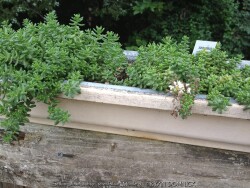



Blue Corsican Sedum, is also known as Sedum dasyphyllum 'Major'
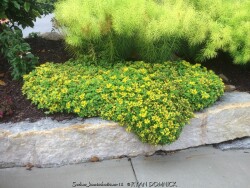

Kamtschaticum Sedum (Sedum kamtschaticum) is known for its compact mats of bright green foliage and yellow-gold flowers in the spring. Fall color turns a beautiful firey orange-red before going dormant. Kamtschaticum Sedum is native to northern China and along the Pacific coast of Siberia including the Kamchatka Peninsula with a similar climate of cold winters and hot summers. Bright green growth emerges early in the spring and spread slowly, rooting a little bit as it spreads but not aggressively. Growth is dense enough to resist most weeds. Kamtschaticum Sedum is useful as a small scale groundcover, rock garden plant, retaining wall plant, or even dry shade gardens. This tough sedum will grow in full sun to full shade in just about any soil except for wet poorly drained ones. Of all of the sedums, this is probably the most resistant to any kind of problems including root rot. I have witnessed clumps surviving and thriving for 20-30 years or more. There is really almost no maintenance with this sedum but you may choose to weed eat it in the winter for a more tidy appearance. The only slight problem is that when grown with too much water, The crown opens up as it flops over and looks slightly untidy. The flowering period is also pretty short. Considered one of the best plants for solving your most difficult dry-shade landscape challenges.
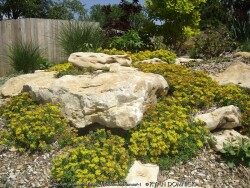

Kamtschaticum Sedum (Sedum kamtschaticum) is known for its compact mats of bright green foliage and yellow-gold flowers in the spring. Fall color turns a beautiful firey orange-red before going dormant. Kamtschaticum Sedum is native to northern China and along the Pacific coast of Siberia including the Kamchatka Peninsula with a similar climate of cold winters and hot summers. Bright green growth emerges early in the spring and spread slowly, rooting a little bit as it spreads but not aggressively. Growth is dense enough to resist most weeds. Kamtschaticum Sedum is useful as a small scale groundcover, rock garden plant, retaining wall plant, or even dry shade gardens. This tough sedum will grow in full sun to full shade in just about any soil except for wet poorly drained ones. Of all of the sedums, this is probably the most resistant to any kind of problems including root rot. I have witnessed clumps surviving and thriving for 20-30 years or more. There is really almost no maintenance with this sedum but you may choose to weed eat it in the winter for a more tidy appearance. The only slight problem is that when grown with too much water, The crown opens up as it flops over and looks slightly untidy. The flowering period is also pretty short. Considered one of the best plants for solving your most difficult dry-shade landscape challenges. Tooth-Leaf Kamtschaticum Sedum (Sedum kamtschaticum var. middendorffianum) is a shorter more drought tolerant variety with tooth-like jagged edges. The clump does not open up and flop. This variety is also more tolerant of full hot sun and shallow soils also making it an ideal roof-garden plant.
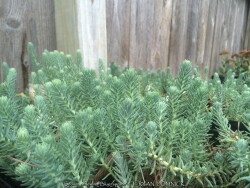

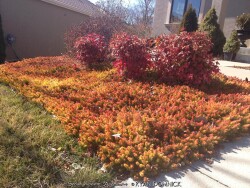

Angelina Gold & Orange Sedum, is also known as Sedum rupestre 'Angelina'


***Description for this perennial available with future update!*** NEEDS EDIT>>>>>> Sedum Prima Angelina has a denser, more compact habit and more vivid golden color than Angelina. According to Plant Delights nursery, "Sedum rupestre 'Prima Angelina' is a superb new improvement of the wildly popular, Sedum 'Angelina'. This compact, better-branched, brighter colored sport was discovered by Ohio's Jared Hughes. Sedum 'Prima Angelina' has thrived in our hot, humid summers. We particularly like that this new gem remains bright gold in cold weather, where its' parent takes on an orange cast in winter. So far, no flowers have been observed on the sport."


Sunsparkler Angelina's Teacup Gold & Orange Sedum, is also known as Sedum rupestre 'Sunsparkler Angelina's Teacup'


Sedum (Mixed Groundcover flats), is also known as Sedum sp.